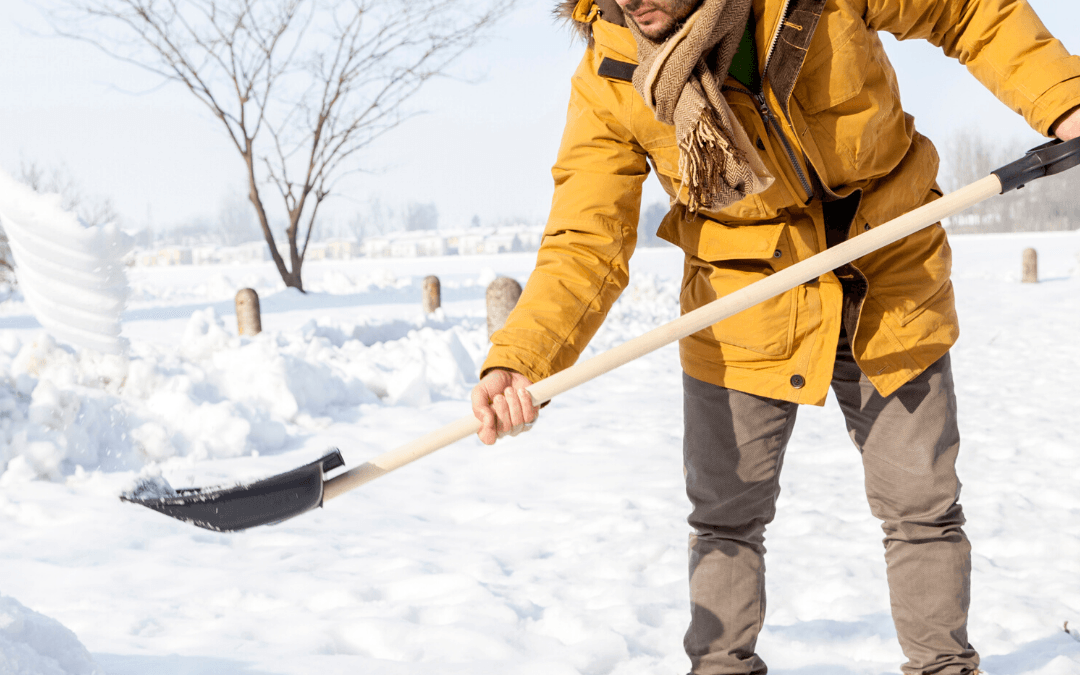
Now that the snow is here to stay are you finding shovelling to be a pain in … The shoulders? The back? The neck?
To help you this season here are some tips to help you prevent injury and make the job a little bit nicer on the body!
Prepare
Warm-up and stretch
Especially important if you’ve been inside relaxing or at work. Do a few arm circles torso twists, hip circles and forward bends to get the muscles ready for the work ahead!
Dress in layers
As you start shovelling you will start to sweat and it’s important to have a bottom layer of clothing that will wick sweat away from your body and a top layer to prevent the damp layer to get cold and chill your body as you work.
Make sure you have time!
We get it! Sometimes the alarm doesn’t go off on time or we get a surprise snowfall. When possible plan in advance and give yourself lots of time to get the job done. Many injuries happen when shovelling becomes a rushed job and we try to do the job too quickly by shovelling large amounts and getting no breaks.
During Shovelling

- Keep your feet hip-width apart.
A wider base of support can help prevent slips/falls and helps put more of the workload into your lower body, away from the back and shoulders.
- Bend your knees and keep your back straight.
Keeping your back straight places you in a more ergonomically safe position where your muscles can work more efficiently and easily when lifting and bailing snow.
- Try not to twist your torso when lifting snow.
Instead, step and turn your whole body towards where you are going to move the snow. This helps prevent over-rotating and straining joints/muscles past their point of tolerance.
- Shovel small amounts of snow at a time.
When there is a large amount of snow on the ground don’t dig directly towards the bottom of the pile. Instead, start with a small amount at the top and work your way down. It will make each scoop more manageable and be less likely to break you or your shovel.
- Don’t throw the snow; instead, walk it over to where you want to pile it.
Throwing the snow can take you outside of that strong base of support we mentioned in tip #1 and can create an excessive amount of strain through the whole body. Walking it over may increase your step count but is overall easier on the body.
- Take breaks!
Giving yourself a chance to recover occasionally is very important to help prevent overstressing the muscles, especially for those who aren’t used to large amounts of physical activity. Every 5 minutes stand up straight, pull your shoulders back, take some deep breaths and take a sip of water.
- Change your shovelling style often
Switch off between snow shovelling right-handed and left-handed and periodically change your grip on the bar (palm under vs. palm over). Doing so helps you work different muscle groups and prevents overuse injuries.
After Shovelling

Give yourself a cool downtime with some gentle stretches through the body. Here are some great examples:
Chest stretch: Stand up tall, interlace your fingers behind your back and open up your chest hold 30 seconds.
Shoulders: reach right arm straight out in front of you, bring that arm across the body. Hook the left forearm under the right arm, supporting the right arm above the elbow. Use the left forearm to pull the right arm further in and across the body, stretching the back of the right shoulder. Hold 30 seconds then repeat on the other shoulder.
Upper back twist: sit in a chair, place your right hand on the outside of your left thigh, left hand behind you on the chair and gently twist towards the left until you feel a gentle stretch. Take deep breaths as you hold 30 seconds then repeat on the other side.
Hamstrings: Laying down on the ground, grab a belt or long towel and wrap one end around one foot while you hold the other end in one hand. Keeping your knee straight pull on the belt, raising your heel up towards the ceiling until you feel a gentle stretch in the hamstrings. Hold 30 seconds then repeat on the other leg.
Lower back release: laying on the ground place your legs onto a chair so your knees are above the hips and your calves are resting comfortably on the seat of the chair. Breath deeply.
These stretches can help prevent lactic acid build-up in the muscles (which creates that post-workout ache) and gives your heart rate a chance to slow down in a healthy manner.
Would it be better to get a Snowblower?
Snow blowers can be a great option for those who often need to remove snow from a large area such as a long driveway or open lot and can save time and effort through the winter months.
Here are some things to consider before making an investment:
- Snowblowers take up storage space all year round and require maintenance and fuel to function.
- Some shovelling is still needed to clear off stairs or tight areas the snowblower can’t get into.
- There may be many times when there is not enough snow to justify using a snowblower, but still enough to shovel. So, even if you own a snowblower, these key shovelling tips will still apply to you!

Hopefully, these tips are able to help you this winter! Is there something in this article you would like to learn more about or did we miss a topic you wanted covered? Send us an email we would love to hear from you!
☎️ (902) 370-2327
📧 reactivewellness.yoga@gmail.com

